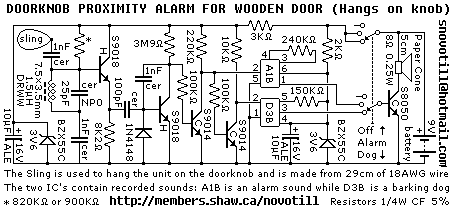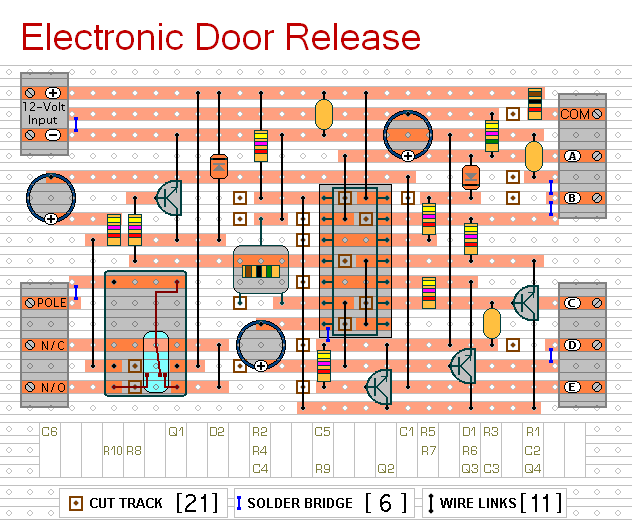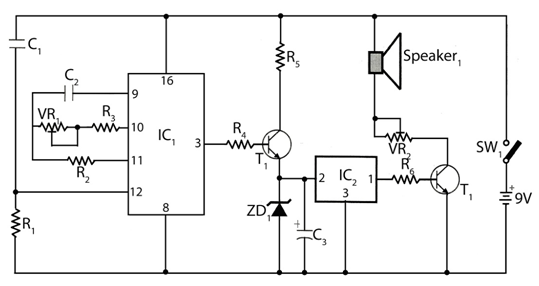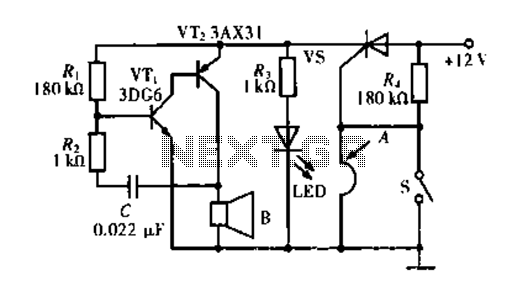
Doorknob Proximity Alarm for wooden door

Reverse engineered circuit diagram of a popular retail doorknob alarm. It contains a small transmitter and the doorknob acts as an antenna so it will not work on a metal door. When a person comes close to the doorknob this loads down the oscillator and the alarm sounds. The proximity sensor circuitry is perfectly capable of driving 74HCT series CMOS logic in place of the sound effect ICs shown in the circuit diagram.
The doorknob alarm circuit operates on the principle of proximity detection using a low-power transmitter and a resonant oscillator. The circuit is designed for non-metallic doors, as the doorknob itself serves as an antenna to transmit a signal. The oscillator generates a radio frequency signal, which is emitted through the doorknob. When a person approaches, their body introduces a capacitive load to the oscillator, causing a shift in the frequency. This frequency shift is detected by the circuit, triggering the alarm.
The core components of the circuit include a transmitter module, a proximity sensor, and an alarm output stage. The transmitter module typically consists of an oscillator circuit, which may be built using a 555 timer IC or a similar oscillator design. The output of this oscillator is connected to the doorknob, allowing it to function as an antenna.
The proximity sensor is designed to detect changes in capacitance caused by the presence of a nearby person. This sensor can be implemented using discrete components or integrated circuits, such as the 74HCT series CMOS logic, which allows for greater flexibility in the design. The CMOS logic can be used to drive various output devices, including sound effect integrated circuits (ICs) or other alarm mechanisms.
When the proximity sensor detects a significant change in the load on the oscillator, it activates the alarm output. This output can be configured to drive a sound-producing device, such as a buzzer or speaker, alerting occupants of the door's proximity to an intruder. The circuit may also include additional features such as adjustable sensitivity, delay timers, or LED indicators to enhance functionality and user experience.
Overall, this reverse-engineered doorknob alarm circuit exemplifies the integration of simple electronic components to create an effective security solution for residential applications.Reverse engineered circuit diagram of a popular retail doorknob alarm. It contains a small transmitter and the doorknob acts as an antenna so it will not work on a metal door. When a person comes close to the doorknob this loads down the oscillator and the alarm sounds. The proximity sensor circuitry is perfectly capable of driving 74HCT series CMOS logic in place of of the sound effect IC`s shown in the circuit diagram.
🔗 External reference
The doorknob alarm circuit operates on the principle of proximity detection using a low-power transmitter and a resonant oscillator. The circuit is designed for non-metallic doors, as the doorknob itself serves as an antenna to transmit a signal. The oscillator generates a radio frequency signal, which is emitted through the doorknob. When a person approaches, their body introduces a capacitive load to the oscillator, causing a shift in the frequency. This frequency shift is detected by the circuit, triggering the alarm.
The core components of the circuit include a transmitter module, a proximity sensor, and an alarm output stage. The transmitter module typically consists of an oscillator circuit, which may be built using a 555 timer IC or a similar oscillator design. The output of this oscillator is connected to the doorknob, allowing it to function as an antenna.
The proximity sensor is designed to detect changes in capacitance caused by the presence of a nearby person. This sensor can be implemented using discrete components or integrated circuits, such as the 74HCT series CMOS logic, which allows for greater flexibility in the design. The CMOS logic can be used to drive various output devices, including sound effect integrated circuits (ICs) or other alarm mechanisms.
When the proximity sensor detects a significant change in the load on the oscillator, it activates the alarm output. This output can be configured to drive a sound-producing device, such as a buzzer or speaker, alerting occupants of the door's proximity to an intruder. The circuit may also include additional features such as adjustable sensitivity, delay timers, or LED indicators to enhance functionality and user experience.
Overall, this reverse-engineered doorknob alarm circuit exemplifies the integration of simple electronic components to create an effective security solution for residential applications.Reverse engineered circuit diagram of a popular retail doorknob alarm. It contains a small transmitter and the doorknob acts as an antenna so it will not work on a metal door. When a person comes close to the doorknob this loads down the oscillator and the alarm sounds. The proximity sensor circuitry is perfectly capable of driving 74HCT series CMOS logic in place of of the sound effect IC`s shown in the circuit diagram.
🔗 External reference





